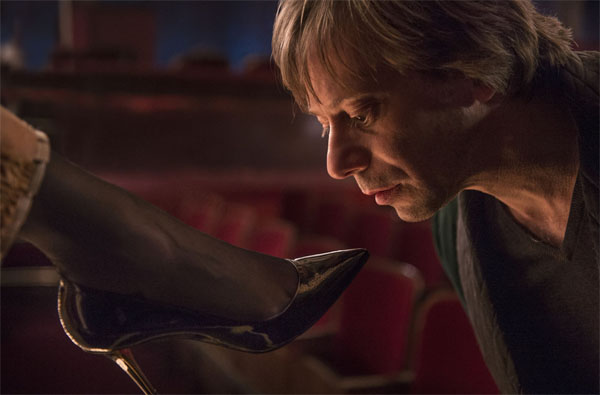“Roman Polanski follows up his Beckett-lite burlesque Carnage with another single-set farce,” begins Time Out New York‘s Keith Uhlich, “the initially subdued, soon gloriously unhinged Venus in Fur. “As always with Polanski, the narrative’s eccentricities are cloaked in an expert veneer of classicism. There are few directors as adept at shot-reverse shot conversation scenes (love the one here where costar Mathieu Amalric is framed over the blurry top portion of a script) or at sinuous Steadicam tracks that create the subtlest sense of unease. One such beauty opens Venus, a Renais-worthy one-er moving from a rainy Parisian boulevard to the inside of a theater. It’s here that Amalric’s harried playwright, Thomas, meets with air-headed actor Vanda (Mrs. Polanski, Emmanuelle Seigner) for a role in his production of Leopold von Sacher-Masoch’s ode to S&M, Venus in Furs. But there’s much more to this dog-collar-wearing goth ditz than she’s letting on, as there is to Polanski stand-in Thomas, whose tastes, it will be proven, run toward the perverse.”
Vanda is “a chaotic and scatterbrained actress who, in the time-honored way of ‘audition’ scenes in movies, shows up late after everyone else has gone,” notes the Guardian‘s Peter Bradshaw. “Thomas is finally persuaded to give her a try—and of course he is astonished by what Vanda comes up with. Soon their relationship begins to change and Polanski shows how Thomas experiences precisely that forbidden frisson celebrated in the novel. But what’s really going on? Could it be that the apparently dumb, naive Vanda is only acting when she’s offstage? She seems initially perplexed by the nineteenth-century mannerisms of restraint. ‘Conversation was very erotic; conversation was all they had,’ explains Thomas. And conversation is pretty much all we have, in this movie. It is a very theatrical, extended duet of speeches which are declaimed to Row Z.” And it ultimately evolves into “an entertaining spectacle, topped off by a rousing Dionysian finale.”
“Both funny and strangely sensual, it begins with the air of a throwaway screwball comedy and ends up more weird and biting,” writes Time Out London‘s Dave Calhoun. “A late image of Amalric smeared in lipstick and wearing high heels even brings to mind the gender-bending mind games of Nicolas Roeg’s Performance…. You wonder at first if, at 46, Seigner is too old to play this ‘young’ actress. But that, too, becomes part of the game. She looks younger as the film goes on. She becomes more subtle as a performer, as does Amalric. These are both thoughtful, ever-mutating performances. In the end, we feel embarrassed to have thought that Seigner was past it – Polanski has made us complicit in Thomas’s initial rejection of Vanda.”
The Hollywood Reporter‘s David Rooney is not alone in noticing that Amalric “bears a striking resemblance to the younger Polanski…. It’s as if Polanski were winking at the audience about the inherent sado-masochism in every actor-director pact, insouciantly offering up his derriere to be spanked.”
“Although it has a tendency to repeat itself—which could also be charitably interpreted as ebb-and-flow—Venus in Fur is classic Polanski, particularly the rousing, creepy finale,” finds Screen‘s Fionnuala Halligan. For the Telegraph‘s Robbie Collin, this one’s “a doodle in the festival’s margins, perhaps, but it has certainly been sketched with a flourish.” More from Domenico La Porta at Cineuropa.
Updates: “[T]he first act or so had us quite on board,” writes Jessica Kiang at the Playlist. “But the overwrought twists and on-the-nose inversions of the second half, all the bigger for taking place in one contained space, along with the sneaking suspicion that the film thought it was being terribly transgressive and daring when it actually felt facile and not a little skeezy, cooled us considerably.”
Dispatching to Filmmaker, Chuck Tryon focuses on one scene in particular: “Vanda is hypothesizing about Thomas’s life and gets him to disclose that he has a Labrador named Derrida (she had discussed Bourdieu), after the famed deconstructionist theorist. The joke prompted one of the biggest laughs in the Palais…, but it provides a key to the play and to Polanski’s fast-moving adaptation and the ways in which his film functions to tear apart and rebuild the gender politics of classical literature and drama, and of the dynamics of male directors (including Polanski himself, who admitted during the post-film press conference that he ‘dominates’ his actors) trying to control passive female performers, who often function as objects of a male gaze. It’s also about the politics of authorship and the ways in which writers who adapt others’ texts may have their own anxieties about the originality of the material they produce.”
Updates, 5/26: For Mike D’Angelo, dispatching to the AV Club, “what’s most impressive is the speed and dexterity with which Seigner, who stank up Polanski’s Frantic a quarter-century ago, moves back and forth between the multiple personae this role provides/demands. If you stay married to a world-class director long enough, and keep being cast in his films, I guess you eventually learn how to act.”
Variety‘s Scott Foundas notes that Venus evokes “such other hybrid theater/cinema works as Louis Malle’s Vanya on 42nd Street, Manoel de Oliveira’s The Satin Slipper and multiple films by Alain Resnais and Jacques Rivette” and that this is Amalric’s “second feature-length psychotherapy session of this year’s Cannes (after Arnaud Desplechin’s Jimmy P.)… As the two Vandas, Seigner faces the challenge of playing an actress playing a character who may herself be a spurned goddess in disguise, and she moves nimbly through the myriad layers of artifice, sometimes fully ‘in’ her 19th-century alter ego, sometimes outside it, commenting on Sacher-Masoch’s text through the contemporary Vanda’s postmodern, feminist gaze.”
“In terms of sheer cinematic craftsmanship, Roman Polanski has few living rivals,” writes Richard Porton at the Daily Beast. “He always knows precisely where to place the camera, consistently elicits fine performances from actors, and, although most of his recent films have been trifles, is probably incapable of making a genuinely bad movie.” But: “[C]an a filmmaker transcend the limitations of theatrical claustrophobia and produce something other than mere canned theater? The fact that Polanski doesn’t totally succeed in this mission has much to do with the weakness of his source material.”
“When the festival ends tonight, Polanski may not win another Palme d’Or to put alongside his prize for his 2002 Holocaust drama The Pianist, but he’ll certainly have made one of the best-liked, and raciest, films of this year’s competition,” writes Jonathan Romney in the Independent.
Updates, 5/27: “It’s frisky, funny stuff, unavoidably slight but given considerable verve by the game performances,” writes Guy Lodge at In Contention. “Venus in Fur finds Polanski repeatedly thumbing his nose at armchair psychologists too quick to find overarching themes in this (or any other) work. ‘How can you play her so well and be so fucking stupid about her?’ fumes Thomas, when Vanda suggests the play is in fact ‘all about child abuse.’ It’s enough to make you briefly wonder how many Polanski classics we’ve misread by the director’s standards; not that this flavorful diversion invites repeated readings in the first place. He’s having palpable fun here, but I’m ready for him to go play outdoors.”
“While the social commentary at the heart of Venus in Furs is rich and the repartee is enjoyable, I must confess that his version of Yasmina Reza’s Carnage had a little bit more oomph,” writes Jordan Hoffman at Film.com.
Update, 5/28: For Kaleem Aftab, writing in the Independent, “where cinematographer Pawel Edelman found surprising angles and brought the New York apartment alive in Carnage, here the action feels like a play that’s being taped for posterity. It’s all rather flat, which is a surprise because the Edelman / Polanski partnership, that started with his Palme d’Or winning The Pianist and has now reached five films, is usually inventive.”
Update, 5/31: Ioncinema‘s Nicholas Bell argues that “detractors of the sometimes forced Carnage should revel in this latest effort, a dark labyrinth of comedic mind games that does with words what something like Lady from Shanghai does with mirrors.”
Update, 6/9: Sundance Selects has picked up US rights, reports Indiewire‘s Peter Knegt.
Cannes 2013 Index. And you can watch over 100 films that have seen their premieres in Cannes right here on Fandor. For news and tips throughout the day every day, follow @KeyframeDaily on Twitter and/or the RSS feed. Get Keyframe Daily in your inbox by signing in at fandor.com/daily.






